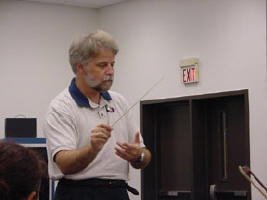|
Score Study
and Rehearsal Preparation |
Rehearsal Preparation
Score Analysis (Marking the
Score)
Practical Analysis
Organization of Rehearsal
Time
|
Effective rehearsals begin long before the downbeat! |
-
Organize a plan -- write it down.
-
Identify goals and objectives for the performance and the scheduled rehearsals.
-
Post repertoire to be studied during any given period with a detailed list of instrumentation for each work -- include any unusual instrumentation or transpositions that may require more attention.
-
Post seating assignments for each work to encourage preparation of parts.
-
Post a detailed schedule for at least a two week period including specific literature and time allowed for each work (this will prevent a student who does not play every work from wasting time and it encourages mental and technical preparation).
Score Analysis (Marking the Score)
-
Instrumentation and transpositions
-
Terms
-
Tempi
-
Meter changes
-
Dynamics
-
Identification of primary and secondary melodic material
-
Phrase analysis/cadences
-
Formal structure/harmonic analysis
-
Texture/balance
-
Style (bowings, articulations, breath marks)
-
Ornamentation (trills, grace notes)
-
Unusual tonal effects
-
Musical interpretation
-
Historical and traditional practices
-
Edition of score and parts (make sure score and parts match)
-
Rehearsal letters or numbers
|
Anticipate problems and determine possible solutions! |
-
Rhythm
-
Intonation
-
Technical problems -- fingerings, range, tone
-
Style
-
Articulation
-
Tempo changes
-
Meter changes
-
Transpositions
Organization of Rehearsal Time
-
Outline specific rehearsal routine.
-
Identify literature and movements to be rehearsed.
-
Set the amount of time allowed during a rehearsal on specific excerpts.
-
Consider the overall rehearsal structure.
-
Opening: announcements; tuning; warm-up; review; development of technical skills
-
Middle: specific excerpt work
-
Closing: play through of large sections of movements; continuity work; end rehearsal with students feeling positive about their work
-
Always be sensitive to the age group and their appropriate attention span, concentration level, room temperature, time of day, season of the year, general activity level of students, and emotional mood of the group.
-
Think on your feet -- a lesson plan is useless if you are not communicating with that particular group of students on their level.
| A rehearsal plan is always dynamic and may need to be modified as the rehearsal progresses. |
| If you would like to be added to the TSMP Email Mailing List and receive periodic notifications of new articles and updates to this website, then please email TSMP.
The Texas School Music
Project is a source for ideas and information
concerning pedagogical
practices in the music classroom or rehearsal hall. The TSMP is a service provided to
all music specialists by the faculty
of
the Department of Music
at Stephen F. Austin State University. Copyright ? 2002, Department of Music at Stephen F. Austin State University |


